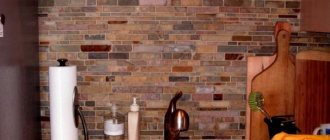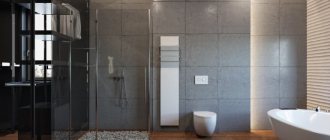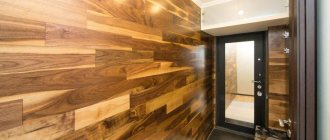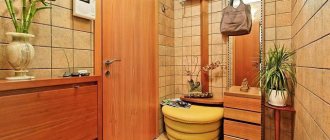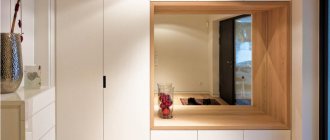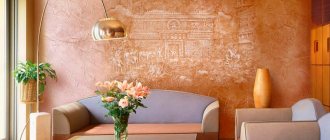Advantages and disadvantages of tiling flooring
In addition to dirt and water, sand and salt get into the corridor.
They are frequent visitors, especially in winter. Therefore, special requirements are placed on the flooring in the hallway. In addition to strength, water resistance and durability are essential.
It is believed that wooden floors are an almost ideal option. And they are preferred for the naturalness and environmental friendliness of the coating. But no matter how carefully the surface of the board is treated, sooner or later it will become unusable due to constant contact with water.
Linoleum is also popular. It is washable and waterproof. With proper care it lasts a long time. But this material is easily deformed. And in the corridor, the load on the floor increases, especially in winter.
And only tiles meet all the above requirements. In addition, it has many advantages:
- The smooth surface is easy to clean from dirt.
- Not at all afraid of water.
- Withstands heavy loads and even impacts.
- The tiles are completely fireproof.
- Can cool the room in hot weather.
- The damaged part of the floor can be easily replaced.
- Harmless to humans.
The shortcomings of the material are minor and can be easily eliminated. The main highlight is weak sound insulation, but in the hallway this is not as important as in the bedroom. Surface may be slippery.
In addition, the material can be easily combined with others. For example, tiles and laminate go well together in one room. True, the room should not be small.
Ceramic tiles “under laminate”
For a long time, apartment owners and homeowners actively used laminate as the main flooring material. However, compared to tiles, it is much less durable and practical. What to do? Abandon many years of tradition? Manufacturers came up with a solution - they began to produce tiles styled like laminate.
Externally, it is very difficult to distinguish - tile manufacturers are so meticulous in conveying the nuances of the texture of the popular flooring material.
It looks like a good laminate of at least class 33, but will last much longer - once again we raise the topic of the durability of tiles as a flooring material.
You definitely won't be able to get this floor dirty. The somewhat dirty, deliberately careless texture creates a soulful and warm atmosphere in the room.
Criteria for choosing tiles for the hallway
When choosing a floor covering, it is always necessary to take into account the specifics of the room. In the corridor there is high load on the floor - heels, dirty shoes and high traffic. Not all materials can withstand such conditions.
Of course, you can limit yourself to ordinary linoleum with a high wear resistance class. But what if you want something more sleek and elegant? And this is where modern floor tiles come to the rescue.
Consider these nuances:
- Choose a material that is not afraid of mechanical damage. Including abrasive influences, detergents, household chemicals;
- Seal the joints to prevent dirt and water from accumulating between them. A special waterproof putty will come to the rescue;
- Don't forget about dirty shoes when choosing a tile color. And then the corridor will always be clean and well-groomed;
- Remember safety. Choose collections with a special non-slip coating or textured tiles, which you can safely walk on in wet shoes after rain and snow.
Connecting profile
The part consists of two elements: a tire and a strip, which also performs decorative functions. The connection occurs according to the tenon-to-groove principle. Moreover, it remains movable and allows the laminate to increase in size without interference.
Joining floor tiles and laminate using a connecting profile Source mydom.ua
The best tires are made from aluminum alloys. But durable plastic is used just as often. The decorative strip is made of metal, MDF or rubber. It fits into the groove with difficulty, so you will need the help of a mallet. Such profiles are also used for joining not only with laminate, but also with linoleum or carpet.
Methods for laying tiles in the hallway
The following techniques are used for installation:
- The usual one is used for large spaces, and the best effect is obtained by combining tiles of different colors.
- Offset laying is suitable for rectangular corridors. Tiles of different colors look attractive. This is how a coating is laid that imitates natural materials.
- Narrow rectangular tiles, including those similar to parquet, are laid using the herringbone method.
- Parquet laying is used to lay out ceramic tiles that imitate a wooden surface.
- The modular installation begins with an ornament in the center of the corridor and continues along its perimeter.
Choose a grout that prevents dirt and water from accumulating in the seams. Make the joints dark to make them easier to clean.
A diagonal with non-parallel walls visually expands a narrow corridor.
To imitate carpets, tiles with a variety of ornaments and patterns are used.
The tiles are combined with other finishing materials, and the edges of the cladding adjacent to the corridor need to be decorated.
Transition without thresholds
Not everyone likes thresholds and connecting profiles. Therefore, the seam can simply be filled with silicone. The material is selected to match the color of the coating. It’s true that it’s difficult to find colored ones and silicone must be elastic. Otherwise, it will crumble after it hardens.
You can also use a cork compensator. Not to be confused with a technical plug. The compensator is sold in pieces up to 300 cm and the cork in it is well sanded and already painted. The part is attached to the floor using universal glue, and the sides are coated with transparent elastic silicone. In this case, ideal cutting of the laminate is also necessary, and the tiles with it should be exactly on the same level.
Types of tile coverings
Ceramic tiles
This is exactly the type of coating that is implied by the word “tile”. Floor tiles in a hallway differ in many ways from those used in a kitchen or bathroom. It has a much higher density, thickness and grain size. Thanks to these qualities, the material is able to withstand shock and pressure.
The average price of ceramic tiles is from 200 to 1000 rubles per square meter. The price depends on the manufacturer, the newness of the collection and the design. Many companies make patterned tiles from wood or stone, but ceramic tiles remain the most popular flooring option.
Interior tiles look simple, but will last a long time due to increased safety
Porcelain tiles
Porcelain tiles have an excellent appearance and are very practical due to their durability. According to the Friedrich Mohs scale, the material has a load resistance rating of 7.
Manufacturers produce tiles of different thicknesses. It ranges from 7 to 30 mm. In addition, the material easily tolerates frequent temperature changes, which makes it popular for rooms close to the street.
In addition to high strength, the tiles have excellent chemical resistance. The exception is hydrofluoric acid, which corrodes granite. In addition, the material is valued for its ability to eliminate any surface defects when installed correctly.
Vinyl
Vinyl tiles are made from rubberized plastic and stone chips are added to the mixture. Advantages of vinyl: no seams during installation, increased strength and high resistance to mechanical damage.
Vinyl tiles seamlessly replace natural materials in an open area
Quartzvinyl
Tiles are made by combining different materials. In essence, this is a modern PVC surface. Thanks to its excellent wear resistance, it is designed for places with large crowds of people and high traffic.
The tile consists of four layers:
- The first one is made of polyvinyl chloride. Provides reliable attachment to the surface.
- The second one is made of fiberglass, which increases its load-bearing capacity.
- The third strengthens. Made from quartz and vinyl.
- The fourth layer is protective. It consists of polyurethane. It also performs a decorative function.
The material has excellent soundproofing properties compared to others. It has a number of advantages. For example, it is perfect for “warm floors”. Although artificial materials are used in the manufacture of tiles, they are completely safe for humans, as they remain environmentally friendly.
Multilayer tiles
It consists of several layers. The first is thickened polyvinyl chloride, the second is a ceramic base with the addition of granite particles, then a layer of pigmented and green grass. The obvious advantage of such tiles is its high strength. In addition to this, it is not as cool as regular ceramic tiles, but is a bit like laminate.
PBX
Polyvinyl chloride is linoleum that is laid in small parts. Visually, linoleum goes well with ceramic tiles. The coating is soft and easy to install. The natural advantage of linoleum is its low price, but there is also an obvious drawback - it quickly breaks from mechanical damage.
High-quality linoleum replaces ceramic tiles in an open area
Clinker
Clinker is a small brick that has a rectangular shape and is fired using a special technology. Sometimes it is glazed and uneven. Clinker is used not only on walls, but also on open floors.
Clinker brick highlights a small area in the house or hallway
Chemical resistance
In principle, ceramic tiles are a fairly inert material, but tiles are different from tiles. On the packaging you can find a chemical resistance rating, which is expressed in letters from D (minimum resistance) to AA (maximum resistance). You will have to wash the tiles in the hallway more often, and in order not to bother yourself with the selection of specific detergents, it is better to take class A or AA tiles . As a last resort, class B tiles are suitable.
Sizes and shape of tiles
Available in various sizes and shapes. With the right combination, you can achieve a visual expansion of the corridor or correct errors after renovation. The shape of the tiles is square, rectangular, hexagonal, and curly.
Rough tile installation takes less time, but fewer joints provide a cleaner finish. Small tiles reduce the amount of trimming work and make small patterns attractive.
Based on the technical and decorative characteristics of the material, the problems of a specific room and its arrangement are solved.
Expansion of space in a narrow corridor is achieved:
- Striped tiles with alternating light and dark lines;
- Finished with large sized tiles in shades of blue, gray, brown;
- Using bright glossy tiles;
- Using the same materials at the intersection of the corridor with other rooms;
- Zoning the space through a combination of different materials;
- A combination of black and white tiles or highlighting light and dark areas.
Techniques for arranging spacious rooms:
- Use of figured and metlakh tiles in the form of a mosaic;
- Application of large tiles with a three-dimensional pattern;
- Laying carpets with mosaics on the sides in the center of the room.
In the hallway, tiles of higher density and resistance to detergents are used. The place for meeting guests is decorated in the form of a colorful carpet or ornamental motifs.
Decor with imitation wood, laminate, marble, granite, onyx will add originality to the interior, and geometric patterns will add aristocracy.
Based on the characteristics of each type of tile and decorative effect, it is necessary to determine its position on the surface.
Types of flooring
To make sure you made the right choice, check out the tile variations.
The product differs in specific aspects:
- Compound;
- Design;
- Price;
- Characteristics.
Ceramic tile
A material in demand on the construction market. Clay processed using technology is wear-resistant with an attractive appearance.
- However, with strong impacts, a destructive effect on the surface of the material is observed, which is subsequently accompanied by microcracks.
- The material responds adequately to temperature changes, remaining cold.
It will be easier to walk barefoot in the summer than in the winter. Used for design implementations, it impresses with the complexity of patterns, relief surface and smooth coating.
Porcelain tiles
A durable material made from rocks containing clay mass and natural dyes. The porous structure is attractive and does not allow moisture to pass through, so it is suitable for a hallway.
But the installation process is extremely difficult. Another drawback is the high cost. However, by entrusting the work to a professional, you don’t have to worry about the installation.
Quartz, vinyl
This material is not afraid of temperature changes, detergents and weights. Contains organic compounds that increase the strength and ductility of the product. There are a variety of tile shapes on the market.
- Thanks to artificial components, the effects of harmful chemicals on human health are prevented.
- Although the time spent in the hallway is occasional, if necessary, it is possible to easily replace individual slabs.
- From an interior design point of view, there will be no drastic changes.
Each slab is bulky, which makes installation difficult. First, the floor surface is leveled. Minimal unevenness will negatively affect movement.
Palette of shades
By placing light tiles in the hallway, you can visually move the room away. A snow-white palette, beige, grayish shades, walnut and pastel colors are excellent options for this. But such tiles on the wall require constant attention, as dirt is immediately noticeable.
However, this feature is also characteristic of a dark floor, when it is very smooth and even small scratches are visible. In addition, such a shade can significantly limit an already small space.
The best options for floor tiles in the hallway are shades of muted tones.
Pay attention to the color. Any cold and dark shades visually contribute to the removal of objects. The property of light colors is to bring them closer together.
Black
A hallway with a black floor should be spacious enough, otherwise the color will narrow the space even more. On this type of floor the damage is most noticeable. Therefore, black tiles are often combined with white tiles, arranged in a checkerboard pattern.
Gray
The most popular and winning option for the hallway, it harmonizes with any wall design. Scratches and dirt are not so noticeable on it.
Beige
Beige belongs to neutral and warm tones. Such a floor in the hallway would rather serve as a backdrop for decoration than attract attention.
Blue
The choice is controversial, which is why it is more common in two-tone floors.
In the photo, a contrasting blue border favorably complements the ornament on a white background.
Red
This color in the hallway is often used in combination with white or as part of ornaments in muted tones - pink, burgundy.
White
Glossy white looks elegant and can be combined with any shade. Bright tiles reflect light and expand the space. But for a hallway this is an excessively slippery coating, and on products with a rough surface and light grouting, the dirt will be more noticeable.
The photo shows white tiles at the entrance, combined with the walls and light wood.
Texture solutions
Glossy floor tiles in a small hallway to visually expand the space.
There are four types of tiles:
- Glossy - with a mirror effect. It reflects all the details of the interior. Such tiles are not recommended for small areas. Any damage will be visible;
- Matte - no traces of dirt are visible on it. No reflective effect, so color shades are better visible;
- Satin is a tile with minimal relief, which makes its pattern play in the rays of light;
- Structural – imitation of natural stone and wood.
Matte tiles for finishing the hallway.
When approaching the issue of choosing tiles for a corridor from a practical point of view, matte and satin are often used.
What tiles look like in different styles
Thanks to its variety, ceramic coating is suitable for all styles.
Modern
Style is based only on practicality. But don’t forget about the attractive component. The design should look good and fit the overall concept of the room.
Based on practical decisions, only the most affordable materials are selected. Also for the same reason, a dark design option is more justified. But finishing in a light style is allowed if the concept does not require it. There are no restrictions on the palette.
For finishing, you can choose monolithic blocks or with a clear geometric pattern. It is allowed to dilute large elements with small inserts. The essence of the idea is the unification of opposites.
For modern style, any experiments are acceptable. You can abandon generally accepted norms and lay out the floor with small light tiles, surrounding it with dark walls. An interesting option with a black floor and white walls. You can try to assemble a multi-colored mosaic on the surface. The main thing when finishing is to be guided by practicality.
Minimalism
For minimalism, choose one tile in a basic shade. The rigor and simplicity of minimalism should also be shown in the flooring.
Loft
Thanks to its variety, ceramic coating is suitable for all styles.
Lofts prefer (often distressed) faux wood floors in the hallway. Minimalism is characterized by tiles with a laconic pattern: white, gray, with the texture of concrete. Floor products imitating natural stone emphasize the sophistication of the classics.
The photo shows a loft-style hallway with black and white patterned tiles.
Provence
For a stylish interior, a light floor made of small bricks and figured fragments is suitable. This design takes on the features of lightness and romanticism inherent in the casual style. If you don’t want to focus attention on the floor, take tiles that imitate existing parquet in a light shade.
Scandinavian
In the Scandinavian style, patchwork is now more popular. Adherents of high-tech choose a modern design for the hallway floor, emphasizing the smooth lines of furniture and decor.
If you adhere to traditions, the style involves the use of a large number of white surfaces. This is due to the fact that in Scandinavian countries there is no sun for more than half the days of the year. Therefore, light glossy surfaces with a minimum of ornaments and designs are popular.
The ability to diffuse low light is important in small, cramped hallways. Therefore, in narrow hallways the use of white Scandinavian style is completely justified.
But you can give preference to light brown tones. In this case, the tiles are selected to imitate wood. The floors are tiled with brown tiles, and one of the walls is tiled in the same color. It is best to take the one with furniture. The remaining surfaces remain as light as possible.
Classic
The classic interior uses light colors, glossy surfaces and natural materials. For a stylish setting, choose marble tiles with gold or silver embellishments, bold patterns and a vibrant appearance.
Marking
The floor can be marked before applying the primer, but dust and debris must be cleared in advance. By the way, it is not necessary to mark the floor in all cases. An experienced builder, for example, can lay tiles without markings at all. However, it will be difficult for a beginner to cope with the job without such preparation.
As a rule, markings begin from the center of the room. This center is determined as follows: first, mark the middle of the short walls, then the long ones, after which the points are connected to each other (it is convenient to use coated thread for this). The place where the lines intersect will be the center of the room.
Laying tiles on the floor diagonally
On a note! In a small hallway, you can start laying tiles not from the center, but from the corner, which is most visible when entering the room.
Also note that it is very important to lay the first row of flooring evenly. Otherwise, the material will not lie correctly.
Combining tiles with other coatings
To zone the space, combinations with other materials are used. In order for the transition from one area to another to be smooth and harmonious, it is necessary to properly design the joints. The seam can be straight or curly, depending on the materials used.
You can combine tiles with parquet, linoleum, and carpet.
The area at the entrance, covered with ceramics, may be higher than the rest of the floor, but not more than 5 cm.
The combination with laminate gives a decorative effect and at the same time divides it into 2 zones: the entrance and the one where you can walk barefoot or in slippers.
Design options for the interface between laminate and tiles:
- A flexible profile is used.
- Decorative flexible strip with a wavy edge.
.
A connecting profile along the edge with carpet and linoleum is also used.
In this case, not so much aesthetics are taken into account as the safety of the structure. A reliable option would be to seal the seam with silicone to match the color of the lining or use a cork condenser.
The floor is selected in the style of the general layout of the house or individually for the hallway. In any case, you must be guided by the features of the style.
Tiles and linoleum
This type of docking is cheaper and less problematic. Linoleum can be cut in different ways, for example, in a wave or in a semicircle. To combine space and eliminate floor differences in the hallway, a metal threshold is usually used.
The photo shows ceramic trim on the threshold and laid linoleum in the rest of the corridor.
Parquet and tiles
Parquet is the most vulnerable floor covering. It is definitely not possible to use parquet flooring in the hallway. It is very soft and scratches easily. Absolutely all objects, including heavy and hard ones, enter the apartment through the front door. Hence the rule:
If you use parquet throughout the apartment, then at the entrance to the corridor you must create a tile area.
The good news is that parquet goes well with level 1 tiles. Both materials are glued together; both do not require a buffer zone at the joint. Thus, the parquet and tiles fit perfectly next to each other, and the seams are filled with mortar.
Some take risks and make the floor in the hallway from natural wood.
Tiles and laminate
Absolutely pointless option. We have already found out that there is no point in using tiles in the entrance area and laminate in the rest of the apartment, because laminate will withstand everything without problems.
The most important thing is that the laminate cannot be joined to the tile level. The tiles are fixed with glue; the laminate must be laid loosely, with gaps in front of the wall. This is an important technological aspect.
Rule: we make the joint in the narrowest place, preferably under the door.
Tiles and laminate don't go together. No matter how hard you try, the joint will look bad.
The grout for the floor in the hallway should be very dark.
If you really want to create a tile island in your hallway, at least make it a normal size to keep dirt out of the joint. It is better to tile the entire area up to the door or arch or not lay it at all.
The best option is to lay either only tiles or only laminate throughout the entire corridor.
Pros and cons of combined flooring
Elegant combination of different materials on the kitchen floor
A popular modern trend is the visual division of the kitchen into a dining area and a cooking area. When solving the problem of combined floors, you should pay attention to the combination of floor coverings.
The main advantages of the combination of materials:
- the opportunity to make the kitchen more comfortable;
- it’s easy to keep the food preparation area clean and have a more aesthetically pleasing and comfortable surface near the dining table;
- proper zoning of the kitchen space;
- practicality and hygiene;
- protection against premature wear of materials in those areas that can withstand maximum load.
The disadvantages of this combination include:
- the difficulty of choosing materials from which a harmonious combination can be obtained,
- the need for additional processing of joints,
- asymmetry of the room with poorly thought out placement of different surfaces.
If combining laminate with traditional porcelain tiles is not difficult, it is necessary to provide for a combination of tiles and linoleum at the stage of leveling the surface.
Curvilinear joint
In cases where the seam between the tiles and the laminate is not straight, you need to use a flexible threshold. The design is similar to the connecting profile, only the receiving tire is divided into sectors that allow it to be bent along a small radius. And the decorative strip is made of PVC. Although the material is considered elastic, for better bending it is first doused with hot water.
Joining profile for tiles and laminate with a curved joint Source sense-life.com
This profile is also made from aluminum. It also has sectors that help you bend it to follow the curves of the joint. There are also special small shelves. A laminate is placed under it, and the part itself is placed under the tile, covering the joint with a small canopy. But such a small element does not allow leaving a large gap between the tiles and the laminate. Therefore, the latter must be trimmed perfectly.
The subtleties of laying tiles on wooden floors
Laying tiles on a wooden floor in a hallway is considered a long and complex process. These two materials do not combine well with each other and have different characteristics:
- A tree can change in size under the influence of external factors. As humidity increases, the tree expands. Decreases - the wood shrinks. As a result, the top coating is deformed and cracks may appear;
- Wood floors are more susceptible to deterioration than tile floors. Therefore, it is often necessary to re-dismantle the tile covering;
- The adhesive (water repellent) and tiles prevent air from getting into the wood. It is necessary for the tree to work fully. As a result, the base wears out much faster than expected;
- The tile laid on top of the wood should be as light as possible, otherwise over time it may crack in places under the weight of the tile cladding.
It is strictly forbidden to engage in masonry work on a wooden base if two years have not yet passed after installation. If you rush, the tiles will certainly crack when they shrink.
Installation of floor tiles
The surface is cleaned of debris and impregnated with a primer. It is convenient to use a roller with fabric when impregnating. In open space, installation usually begins from the middle. The installation is marked with chalk and the process begins based on it.
The diluted mixture for laying tiles should sit for 10-15 minutes. The adhesive is applied to the floor with a notched trowel and the tiles are pressed against the mortar. For tight shrinkage. The surface of the tile is tapped with a rubber mallet. The horizontalness of each element is checked by a level.
You can adjust the position of the tiles on the glue within 15 minutes, after which the glue will begin to set. After laying the next element, a cross is installed in the gap. After laying all the tiles, the seams are grouted.
- Design of a narrow hallway in an apartment 2022 in a modern style
- Hallway decor - beautiful ideas and ways to decorate a hallway with your own hands (85 photos and videos)
- Mirror in the hallway - modern design ideas using mirrors (110 photos)
Grouting is done with a rubber spatula. It is important not to confuse the grout for walls and floors. The quality of installation depends on compliance with the technology of the entire process, starting from preparing the surface and ending with leveling the entire floor.
Features of heated floors
There are certain advantages of having a heated floor under the tiles:
- environmental Safety;
- favorable temperature conditions;
- increased surface area due to the absence of heating radiators;
- The warm tiles feel good on your feet.
The disadvantages include the complexity of the work and the need to carefully level the surface before installation. Also, during repair of the heating system, all tiles will need to be completely removed.
Hardness and grade
The hardness of the tile is determined according to the Mohs school. It is clear that in the hallway there will be a significant load on the tiles, but still it is not as great as, for example, in production, so you can get by with tiles with average ratings of 6-7 points.
All tiles are divided into three classes: the first class is marked in red, the second in blue, and the third in green. Of course, it is better to take first class tiles. Yes, it costs more, but the share of defective products in this category does not exceed 5%, and for third-grade tiles this figure can reach 25%.
Photo of floor tiles in the hallway
The role of color and texture on the overall appearance of the interior
Tile is a material that is most often used for laying floors in the hallway, kitchen, bathroom and toilet. Tile manufacturers, trying their best, annually produce new shapes, textures, and combined options. The top layer of blocks can be embossed, smooth, or rough. All this makes it possible to create different design projects in apartments. Let's consider how tiles of different textures will look on the floor in the corridor.
Under the stone
Here you can use blocks of different shapes and textures. This is a good choice when decorating a room in a classic or country style. Stone-like tiles can convey different types of texture to the eye, having a characteristic pattern:
- basalt;
- slate;
- granite;
- quartzite.
And finishing the floor with marble will convey the brilliant, attractive texture of onyx, marble and agate.
You can use blocks of different shapes and textures
This material goes on sale in different shades, from monotonous to shades that include different inclusions. Some types of stone blocks are made of porcelain stoneware, which means they have a rough surface. For a floor in a corridor, this is a very good quality, as it will not be considered slippery.
It looks natural in the entrance area to the apartment. The remaining floor area can be designed as:
- sockets;
- whole ornaments;
- panel
Decorative borders with baseboards will also look good.
Wood effect
Wood in any design fills the house with naturalness, adds coziness and comfort. There are tiles on sale that imitate wood of different species:
- oak;
- pine;
- beech;
- wenge.
Each tree has its own unique pattern. You can add elitism to a room with just this tile by successfully choosing the texture and shades. The material is easy to care for and creates a seamless effect when laid.
Fills the house with nature
You can decorate the room with a decorative border, place the blocks in the form of a herringbone, wickerwork (like parquet) or in a spaced pattern. In a word, there are no restrictions in decorating the floor with wood-look tiles. Here the author himself has the right to choose the method of styling and decoration. As well as the type of pattern on the tile and color.
Mirror
Mirror reflection enlarges both space and objects. Using mirror tiles on the floor in the hallway, you can recreate a multifaceted effect. Sold with a matte edge reminiscent of precious metals or tinted. Lays in a square or diamond shape .
To create a decorative effect, craftsmen often decorate several areas with tiles speckled in a pattern. Not bad as a decoration; the built-in lighting will look great.
Beautiful hallway in light colors
Gray
Gray in floor design will give the room coldness, simplicity, and restraint.
Advice A plain gray floor is recommended for those who value laconicism and rigor in the interior. Often such a floor is diluted with some kind of ornament or pattern. Gray tiles on the floor of the corridors look natural.
A successful combination of gray with emerald, white, green, mirror inserts and wood textures. The gray scale has many shades, so tiles of this color can be used as a background . To create a classic style, gray should be combined with some dark color.
Gray – coldness, simplicity, restraint
Beige
Natural color is always relevant in creating design projects. The beige floor in the hallway is a practical option. Looks great in a duet with wooden furniture made in a classic design or with walls finished in wood, natural stone, simple or textured plaster.
The shape of the tiles in beige colors is made in the form of an elongated or equilateral rectangle. It can be plain, or it can imitate the structure of wood, so-called parquet boards. Using brown ones, you can create decorative borders and patterns in the corridor. Any installation methods can be used:
- in the form of squares;
- in a run;
- according to the type of parquet installation.
And also combine different shapes and sizes of tiles.
Natural color is always relevant
Brown
This color on the floor of the corridor will look neutral and expensive. In order to emphasize the nobility of the decoration on the walls or furniture made of natural wood, you can use brown floor tiles. Such an interior will look quite respectable. It is produced and sold in three versions: wood-look, stone-look or completely plain .
- It is more advisable to combine monochrome with decorative details - an accent insert, a pattern or a border.
- Brown wood-look will complement the interior with warmth, coziness and comfort.
- Stone will create a massive effect and add freshness to the room.
Looks neutral and expensive
Some good advice
You need to choose tiles not only for beauty or color, but also for quality. The manufacturer pastes a pictogram on each package indicating the technical and operational characteristics:
- PEI – indicates the level of endurance, measured on a special scale, can have indicators of 1-5 units.
- An icon resembling a laboratory flask indicates that the tile has good resistance to chemically active substances.
- Snowflake is a frost-resistant material.
- Puka - tiles intended for wall cladding.
- The footprint is from floor tiles.
- B - indicates that the tiles were produced by pressing. A – using extrusion technology.
It is also indicated here:
- grade of tiles;
- color, texture;
- thickness, length and width;
- box weight;
- weight of one tile;
- area in one package;
- number of blocks in the package.
Recommendations for selection
- For the corridor and kitchen it is better to purchase rough tiles. This will reduce the level of slipping. But recesses that are too deep will collect dust and dirt. Glazed is endowed with greater strength and water resistance.
- When choosing a color, take into account the overall interior. Porcelain stoneware and ceramics in light colors are equally suitable for the corridor.
- Black and white tiles will quickly get dirty and this will be immediately visible to an outsider.
- Successfully combined with each other: beige, brown and gray tiles.
- Matte is more practical than glossy; scratches on it are almost invisible, which cannot be said about gloss.
- Medium-sized tiles with a repeating texture or pattern visually make the room smaller, but add coziness to it.
Beautiful, light colors
We must not forget about fakes. Do not trust too low prices and dubious manufacturers. Buy the material from a place where they will easily provide you with certificates, and if you find a defect, replace the product or return the full price.

